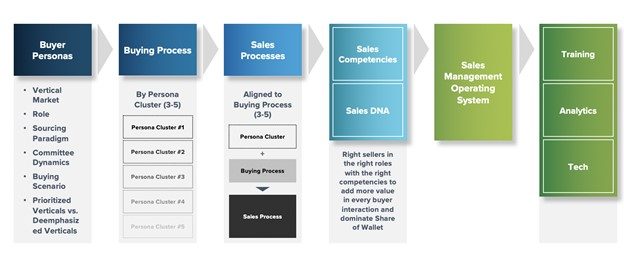Distribution sales forces have been evolving their sales model and processes to address shifting buyer preferences, improve productivity, embrace specialization, and anticipate changing buyer and seller demographics. Sales transformation is something that nearly every company has on its radar in some form.
Some companies explored new sales-coverage models (hybrid inside/outside teams), and differentiated or separated customer service (inbound-call order taking) from outbound-calling inside sellers. Some launched business development representatives (BDRs) to specialize in new-logo acquisition. Many of these changes have improved customer experience, cost-to-serve, productivity, and organic growth.
At the same time, distributors have also shopped for new sales technologies to support their sellers, manage their teams, and gain better visibility into sales performance. Enough time has now passed where we are seeing instances of success and failure across these initiatives. These attempts at sales transformation actually have a very clear root cause, of which underperforming results or poor tech adoption are merely symptoms. The root cause, in simple terms, is putting the cart before the horse. B2B organizations can transform their sales forces and assimilate sales technology much more effectively than they’re currently doing. It starts with understanding the buyer.
How Can You Start the Sales Transformation Journey?
Start your sales transformation journey by taking a deep-dive look at your buyers (and potentially Ideal Customer Profile):
- Who are the key buyer personas and committee clusters (by vertical)
- What problems are they trying to solve?
- What are their buying processes?
- What resources or insights do they seek to advance the buying process?
- How and when do they prefer to engage sellers?
If the seller’s job is to help buyers buy more, then our efforts to design a sales process need to align tightly with buyers’ buying processes, stages and exit criteria. If we skip the step of buyer persona and process research, our sales process will be seller-centric and will predictably create friction and frustration with buyers and undermine seller performance.
The buyer needs to be the North Star for all our efforts to innovate in sales processes, talent selection and development, sales management operating system, and last, but not least, sales technology. That is to say, all the downstream innovation and transformation is disoriented without the buyer-centric foundation. Which is why virtually all the hasty sales transformations mentioned — from training to management to tech adoption — risk failing to deliver the expected results. The sales force’s daily behaviors won’t change until the buyer-first systems approach to selling takes center stage.

In the context of the buyer-centric sales transformation framework, it becomes obvious why some sales transformations fail to achieve the desired outcomes: they are all putting the downstream investment “carts” before the upstream buyer “horse.”
Once we reframe the sales transformation journey, the disconnect quickly resolves. Starting with solid buyer research — and leading into documented buying process stages, resources and exit criteria — we can identify clusters of buyers and buying processes, which support a selling process.
Align and Formalize Your Sales Process to Meet Your Buyers’ Needs
When the sales process(es) have been formalized to support buyers’ process(es), we can delve deeper into the downstream talent selection, training and coaching transformations. We can identify the intrinsic sales talent (seller “DNA”) as well as the extrinsic (learned) sales competencies required to successfully execute the specified sales process. We sharpen the “fit” between sellers and roles, building high levels of sales readiness to support the sales process.
With the right people in the right seats on the bus, we can then focus on the supporting sales management operating system: the prescribed manager activities, competencies, coaching, KPIs, etc. We want to ensure that our sellers master the execution of the buyer-centric sales process that they have been hired and trained to execute.
When this stage is neglected, it results in a failure-to-launch or prevents stickiness in the sales transformation journey. Lacking a formalized sales management operating system, the old, “wild-west” sales behaviors remain, and the intended gains in buyer experience, share of wallet/market share, and seller development go unrealized.
Bridge the Gaps Between Sellers and Buyers
Companies that rigorously research their buyers, align and formalize their sales process, and master the supporting sales management operating system, are in the best position to achieve their sales goals. They have the ability to implement sales tools and technology that increase customer value, accelerate seller performance, and drive business outcomes and ROI. Why? Because this form of sales transformation has first resolved the existential question of what needs to change, and what role sales technology plays in supporting those changes. In this buyer-centric, systems approach to transformation, all the linkages between buyers and sellers are resolved and synchronized — by design.
Sellers understand their buyers, and they know how to serve those buyers on a daily basis. They know the role of sales training and coaching in helping them acquire and master the competencies to successfully execute the sales process. Managers have clear systems, playbooks, and KPIs to apply a continuous-improvement model to accelerate rep performance. And sales technology is intrinsic to how everyone executes the system.
Reorient Your Sales Transformation
The modern, buyer-centric sales transformation requires greater maturity, focus and seriousness compared to the sales-tinkering changes that too often masquerade as transformations. It requires focused time and work. The outcome, however, is a predictable revenue machine that makes it better to be your customer, better to be your seller, better to be your shareholder, and harder to be your competitor.

